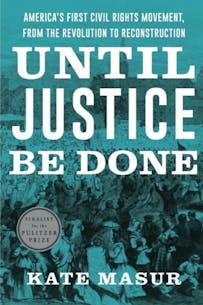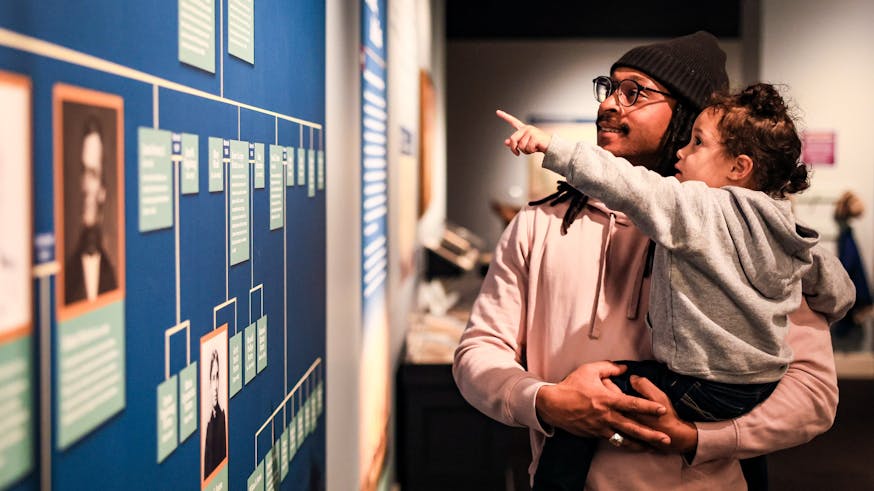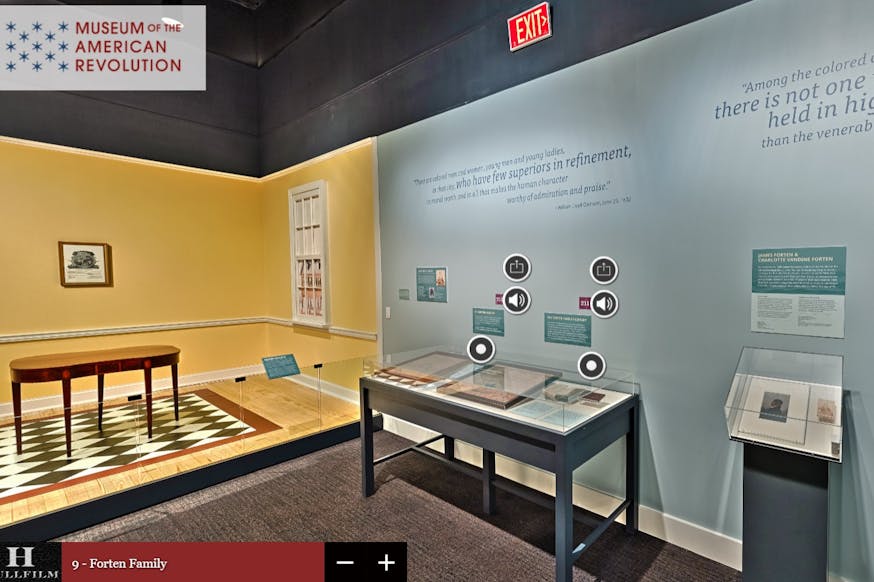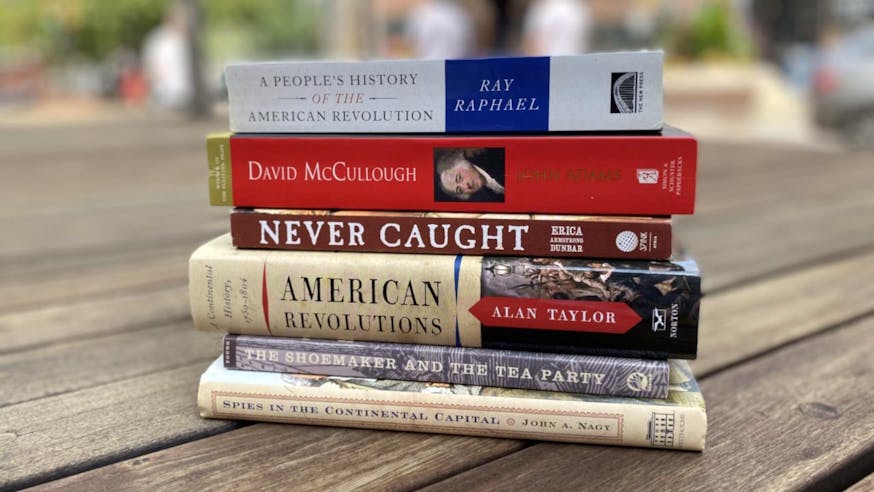Read the Revolution
Until Justice Be Done
July 26, 2023
Purchase the book from W. W. Norton & Company.
Over its first eight decades as an independent nation, the United States wrestled with the future of slavery. The Civil War tore the nation apart over the question of whether “all men are created equal” applied to all people. During the 80 years prior to the Civil War, the nation’s growing population of free Black Americans not only helped to lead the movement to abolish slavery, but they were also at the forefront of what historian Kate Masur considers “America’s first civil rights movement.”
Masur’s book, Until Justice Be Done: America’s First Civil Rights Movement, from the Revolution to Reconstruction, tells the stories of the American people who fought against racist laws on the local, state, and federal levels and pushed the nation to strengthen its commitment to the principle that “all men are created equal.” This civil rights movement touched every state in the union. Ordinary citizens, lawyers, and politicians became activists. Philadelphia, the city with the largest population of free people of African descent in the country and where many people had “strong convictions in favor of abolition and racial equality,” was an epicenter of the movement. Until Justice Be Done informed the research behind the Museum’s special exhibit Black Founders: The Forten Family of Philadelphia, which tells the story of free Black Philadelphian, Revolutionary War sailor, and successful businessman James Forten and his family’s role in combatting laws that undermined their rights as Americans.
Read an excerpt in which Masur contextualizes James Forten as a leader of Philadelphia’s dynamic free Black community in the early 1800s.
Excerpt
The impulse to adopt laws designating free African Americans as a separate class from whites seemed to be spreading. After Ohio, other territories and states in the Old Northwest passed antiblack provisions of their own. As governor of Indiana Territory, William Henry Harrison pushed Congress to permit slavery to continue despite the Northwest Ordinance, but he failed in Washington and faced increasingly organized opposition at home. Slavery remained officially prohibited, but Indiana Territory—and Illinois Territory when it was carved off from Indiana in 1809—passed antiblack regulations that echoed those of Ohio. For instance, in 1803, Indiana Territory required every newly released “servant” to have “his or her freedom recorded” and to receive a certificate that essentially served as a work permit. In 1810, the territory put township overseers of the poor in charge of ensuring that all “black or mulatto” persons under their jurisdiction found someone to post a security of $500 as indemnity against the possibility that they would become “a charge” to the county. Illinois, in turn, disguised itself for permitting long-term indentures that resembled slavery in almost every respect.
The tendency spread to Pennsylvania, which shared a long border with slaveholding Maryland and a shorter one with Virginia. Maryland banned free Black migration into the state in 1807, amid a number of other restrictive measures directed at free African Americans. From then until 1814, Pennsylvanians regularly pressed their legislature to echo Maryland’s ban with one of their own. In the winter of 1813, for example, state representative Jacob Mitchell introduced a petition from Philadelphia residents complaining that people of color were “becoming nuisances.” The petitioners sought a law that would oblige African Americans to register, allow them to be sold for “a term of years” if convicted of a crime, provide compensation to persons they “may have plundered,” and pay the expense of their prosecution. Reflecting perennial concerns about the economic burdens imposed by the transient poor as well as the conviction that free Black people constituted a separate and uniquely challenging class, the petitioners asked that people of color be assessed a special tax to support “their own poor.”
Yet Pennsylvania was not Ohio. Philadelphia in particular was a meeting place for people with strong convictions in favor of abolition and racial equality. Beginning in the 1770s, a Quaker-led abolitionist movement helped make the city a hub of free-Black life. Black Philadelphians—their work infused with optimism born of the Revolution and its promises of equal rights and self-government—nurtured a lively intellectual and educational culture. They published political pamphlets and treatises and established a robust network of teachers and schools. Men and women built a host of mutual aid organizations, including the Free African Society, which worked with white Quakers to advocate the interests of Black Philadelphians. In 1794, the Free African Society gave rise to two independent Black churches: the African Episcopal Church of St. Thomas led by Absalom Jones, and Bethel Church, led by Richard Allen. A Methodist, Allen became the progenitor of an entirely new denomination, the African Methodist Episcopal (AME) Church.
Nor was Philadelphia an island. The city’s Black and white abolitionists cultivated ties to allies elsewhere through a host of institutions and personal connections. In the 1790s, through Quaker connections, the city became an asylum for African American refugees from North Carolina who had been freed by Quaker owners before and during the American Revolution and were in danger of being re-enslaved by state policy. African Americans in Philadelphia, Boston, New York, and other places also forged ties through the Prince Hall Masons, a Freemasonry organization inaugurated in 1775 by Prince Hall, a Boston-born Black man. The white-led New-York Manumission Society and Pennsylvania Abolition Society encouraged peers in other states to form abolitionist societies, and by 1794 they collectively formed the American Convention for Promoting the Abolition of Slavery and Improving the Condition of the African Race, an organization that met regularly to develop strategies for demanding abolition and protecting the rights of free African Americans.
Black Philadelphians and their white allies urged Congress to take action to end slavery and protect the rights of free African Americans. At the end of December 1799, Richard Allen, Absalom Jones, and sixty-nine other Black Philadelphians signed a petition to Congress in which they described themselves as a “class of citizens” of the United States and part of “the People of the United States” who were members of the constitutional compact. They claimed rights as citizens and as human beings, arguing that since neither the Constitution nor the 1793 Fugitive Slave Act mentioned “Black people or slaves,” therefore “as we are men, we may be admitted to partake of the Liberties and unalienable Rights therein held forth.” They wanted Congress to take steps to protect free African Americans from kidnapping, curtail illegal aspects of the international slave trade, and “prepare the way for the oppressed to go free.” The Philadelphia-based Black sailmaker and activist James Forten later wrote that this remarkable petition had spoken for “seven hundred thousand of the human race.” Black Philadelphians like Forten, bolstered by the abolitionist groundswell of the late eighteenth century, pressed the nation as a whole to live up to its most vaulted promises of universal rights.
James Forten was among those who vehemently resisted efforts to bar or regulate Black migration into Pennsylvania. Born to free parents in 1766, he grew up and attended school in the radical climate of revolutionary Philadelphia. His father, a prosperous sailmaker, died when he was a boy, and he volunteered at age fifteen for service aboard a privateer in the American Revolution. On returning to Philadelphia, Forten became a vocal participant in the city’s activist community. In the early nineteenth century, faced with the possibility that their state would adopt antiblack laws like those in Ohio and elsewhere, white and Black organizations petitioned the state legislature to reject the proposal. Forten, for his part, wrote a series of public letters that were published as a pamphlet in the winter of 1813 and in the city’s leading newspaper a year later.
Forten’s eleven-page pamphlet, entitled Letters from a Man of Colour, on a Late Bill before the Senate of Pennsylvania, voiced themes that became central to the struggle against racist laws in subsequent years. He reminded readers of the egalitarian promise of the Declaration of Independence and the Pennsylvania Constitution, both of which claimed that all men were created equal. That equality, he insisted, transcended perceptions of skin color, national origin, religion, or supposed level of civilization. It “embraces the Indian and the European, the Savage and the Saint, the Peruvian and the Laplander, the white Man and the African.” Since all human beings were fundamentally equal in the eyes of God and the law, racial discrimination violated moral principles as well as the founding charters of the nation and his state.
Moving from lofty principles to practical impact, Forten explained how the proposed Pennsylvania law would humiliate and endanger people of African descent who were simply seeking to live peacefully in the community. Imagine, for example, that he had a brother who lived “in a distant part of the Union” and came to visit because he missed his family. Under the proposed law, the brother would be forced to register within twenty-four hours or risk incarceration or even sale into hard labor for seven years. Forten explained how racially discriminatory legislation empowered officials to act on their prejudices, even to the point of inciting violence. The city register would collect the fees, he wrote, but, “Who is this Register?” “A man, and exercising an office, where ten dollars is the fee for each delinquent, will probably be a cruel man and find delinquents where they really do not exist. The poor black is left to the merciless gripe [sic] of an avaricious REGISTER, without an appeal, in the event, from his tyranny or oppression!”
Sign Up
Get biweekly Read the Revolution featured excerpts right to your inbox.
By officially casting Black people as outsiders, Forten argued, the law would sanction white racism and serve as an invitation to mob violence. The measure would invite abuse by officials, he predicted, allowing “police officers… to apprehend any black, whether a vagrant or a man of reputable character, who cannot produce a Certificate that he has been registered.” Authorities could use the law to foment mob behavior among whites:
The Constable, whose antipathy generally against the black is very great, will take every opportunity of hurting his feelings!—Perhaps, he sees him at a distance, and having a mind to raise the boys in hue and cry against him, exclaims, “Halloa! Stop the Negro!” The boys, delighting in the sport, immediately begin to hunt him, and immediately from a hundred tongues is heard the cry—“Hoa, Negro, where is your Certificate!”—Can any thing be done more shocking to the principles of Civil Liberty!
Forten’s vision for law was clear: It must be a source of protection, not abuse, and it must operate without regard to race. Concluding one of his letters, he wrote, “The same power which protects the white man, should protect A MAN of COLOUR.”
The proposed antiblack law failed in Pennsylvania in 1813, and the state never adopted race-based registration laws similar to those in Ohio and elsewhere in the Old Northwest. Yet the next legislative session revealed how laws directed at the poor could substitute when explicitly racist laws seemed unacceptable. As the new session opened in early 1814, Representative Joel Barlow Sutherland introduced yet another petition from inhabitants of Philadelphia, asking for an act to prevent “the migration of people of color into this commonwealth.” The petition went to committee, and Sutherland reported back weeks later, introducing on behalf of the committee a bill titled, “An act to prevent the migration of people of colour into the city and county of Philadelphia.” When debate began, representative Jacob Mitchell, who had introduced a similar bill the previous year, joined Sutherland in sponsorship of the bill. A week later, however, when it was time to discuss the bill a second time, Mitchell announced that he—together with William Duane—was offering a “substitute” for the original.
The substitute bill was dramatically different from its precursor. Now the legislators defined the problem not as one of race but rather of vagrancy. The new proposal empowered the mayor and other Philadelphia officials to “commit to prison any vagrant or other idle or disorderly person living without employment, wandering about begging, having no visible means of subsistence, or being unable to give a reasonable account of himself or herself or of his or her business.” Persons convicted of vagrancy would be forced to labor for various lengths of time, depending on how often they had been convicted. In the ensuing debate, legislators mostly sought to reduce the length of sentences for vagrancy convictions. The House then officially renamed the bill. Instead of bearing a name that associated it with prejudice against persons of color, House Bill 202 was now called “An act to prevent the increase of idle and disorderly persons within this commonwealth.”
With that bit of alchemy, the Pennsylvania House moved from explicit racism to a more politically palatable policy that targeted people based on their perceived class status. The registration provisions and lengthy labor sentences in the original proposal were removed, making the entire law less punitive. It is clear that the legislators had sought a compromise, trying to accomplish their end of discouraging what they saw as idleness without specifically or overtly targeting people of color. The House agreed, by a vote of 49 to 29, to move ahead with this new version of the bill. Sutherland, Duane, and Mitchell—all of whom were already on record supporting measures that directly targeted persons of African descent—signed on, and the House passed the bill. The Senate was not interested, however, and it rejected the House bill at the end of the session. Still, the debate had been instructive. Evidently the language of race and class were to some extent fungible. Legislators who first sought to target African Americans likely knew that authorities could use discretion when enforcing race-neutral laws regulating vagrancy and disorderly conduct, allowing them to accomplish the desired ends even if the statute itself made no reference to race.
Kate Masur, Until Justice Be Done: America’s First Civil Rights Movement, from the Revolution to Reconstruction (W.W. Norton, 2021), 18-24.
Tags
Learn More

Black Founders: The Forten Family of Philadelphia
February 11 - November 26, 2023
Black Founders Virtual Tour

